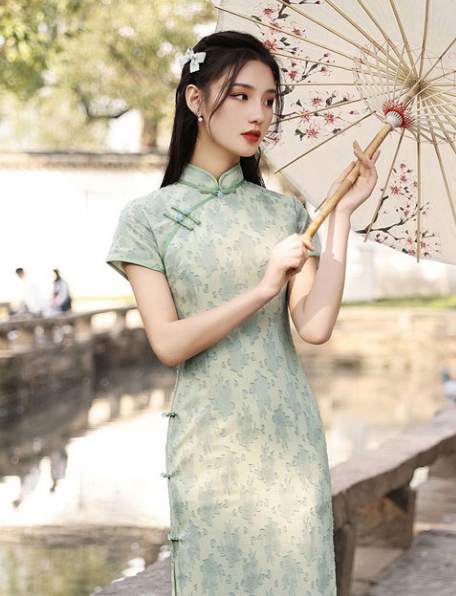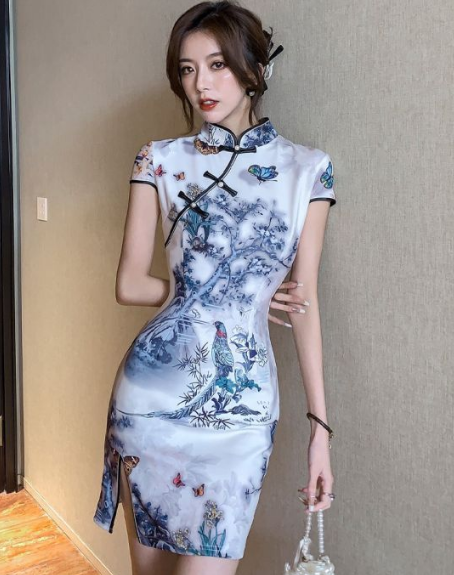Silhouette and Structure
Traditional Fit and Form-Fitting Nature
The cheongsam, with its iconic structure, clings to the body showcasing an elegant silhouette. It traditionally has a high neck and fits snugly, emphasizing the contours of the body. Tailors often custom-make cheongsams to ensure a perfect fit, enhancing the wearer’s figure. This snug fit often symbolizes the grace and femininity associated with the garment’s design.
Slits and Their Cultural Significance
High slits are a hallmark of the cheongsam, starting just above the knee on either side. These slits were not merely for style; they allowed Chinese women ease of movement, especially in the early 20th century. Over time, the slits became a symbol of modernity and fashion, often linked to the burgeoning women’s liberation movement in China. The height of the slits can vary, with some traditional dresses having lower slits while contemporary designs might feature higher ones for a bold statement.

In the crafting of cheongsams, tailors often select silk due to its high quality and luxurious feel, which contributes to the garment’s sleek appearance. The speed at which a tailor can produce a cheongsam depends on the complexity of its design and the proficiency of the artisan. Despite the modern advancements in textile manufacturing, the cheongsam remains a garment where quality trumps speed, with each piece often taking several weeks to complete to ensure its standard and durability.
The aesthetic appeal of the cheongsam doesn’t compromise on the garment’s practicality. Its timeless design balances tradition with versatility, allowing the wearer to adapt it for various occasions without forgoing comfort.
Material and Texture
Preferred Fabrics in Cheongsam Making
Silk reigns supreme in cheongsam fabrication for its supreme smoothness and elegance. Brocade follows, adding texture and depth with its raised patterns. Prices for silk fluctuate, generally falling between $10 to $100 per yard based on quality and pattern complexity.
Texture and Flow: How Fabric Choices Affect the Garment’s Look
Satin gives the cheongsam a fluid silhouette, perfect for evening attire. Cotton and linen, offering structure, are ideal for daily wear and are more budget-friendly, costing around $5 to $20 per yard. Each fabric choice not only alters the garment’s aesthetics but also its appropriateness for various settings and climates.
Durability varies with material choice as well; silk cheongsams can last for generations with careful maintenance, while cotton and linen are more short-lived. Silk requires gentle care and slow drying, whereas cotton and linen can handle robust washing and quicker drying methods.
Collar and Sleeves
The Mandarin Collar: Style and Symbolism
The mandarin collar, standing upright and wrapping snugly around the neck, offers a blend of sophistication and cultural essence. It draws from the Qing Dynasty, where it signified nobility and respect. The collar height varies but typically measures around 1 to 2 inches, balancing comfort with the intended stylistic impact.
Sleeve Variations and Their Historical Evolution
Cheongsam sleeves have evolved from full-length to various shorter styles over time. Early cheongsams featured long sleeves, reflecting modesty and traditional values. As fashions changed, especially during the 20th century, shorter sleeves became popular, symbolizing modernity and freedom. Sleeve lengths can range from sleeveless to cap, short, elbow-length, or full-length, each offering a different level of coverage and movement.
Fabrics like silk and brocade remain popular for sleeves due to their quality and how they maintain shape. The cost for tailoring sleeves can vary, with detailed hand-sewn sleeves increasing the overall price of the cheongsam. The time it takes to create these sleeves depends on the complexity; a tailor might spend several hours on a pair of intricate full-length sleeves. In contrast, simpler cap sleeves can take considerably less time.
Closure and Fastenings
Types of Knots and Buttons
Cheongsams often feature knotted buttons, called ‘frog buttons’, which are both decorative and functional. Crafters meticulously hand-make these from fabric, requiring skill and time. The intricacy of the knot work can vary, but all serve the purpose of securing the garment while adding to its beauty.
The Functionality and Aesthetics of Side Closures
Side closures on cheongsams are not just functional; they contour the body and enhance the silhouette. Positioned discreetly, these closures can include zippers or hooks, and they contribute to the sleek appearance of the dress. While traditional cheongsams had hand-sewn side closures, modern versions often use zippers for ease of wear. The cost of adding a hand-sewn side closure versus a zipper differs, with the former being more labor-intensive and thus, more expensive.
Patterns and Embroidery
Significance of Common Motifs and Colors
Embroidered motifs on cheongsam carry deep meanings. Dragons and phoenixes often represent power and femininity, while flowers like lotus and peony symbolize purity and prosperity. The color red, prevalent in cheongsams, signifies good fortune and joy. Gold, another favored color, denotes wealth and opulence.
The Art of Cheongsam Embroidery: Techniques and Trends
Cheongsam embroidery is a testament to skilled craftsmanship. Hand embroidery remains the gold standard, with techniques like satin stitch or French knot making each piece unique. Contemporary trends blend traditional motifs with modern elements, creating a new aesthetic that resonates with today’s fashion. The cost of hand-embroidered cheongsams can be high, reflecting the time and skill required—often dozens of hours per garment. Machine embroidery offers a more cost-effective alternative, reducing production time significantly while still maintaining high detail and quality.

Contemporary Interpretations
Modern Styling and Accessories
Today, fashionistas pair cheongsams with modern accessories to create a blend of old and new. A sleek cheongsam might accompany high heels, statement jewelry, or a leather jacket for an edgy twist. Contemporary fabrics like stretch cotton and mixed blends add comfort and appeal to younger demographics, allowing for a broader range of movement and a more casual style.
The Cheongsam in Today’s Fashion Industry
In modern fashion, the cheongsam takes on new forms with varied lengths, deconstructed styles, and innovative prints. Designers frequently experiment with the cheongsam’s traditional cut, introducing elements like asymmetrical hems and mixed-material pieces. These innovations respect the garment’s heritage while pushing it into the high-fashion realm. As a result, the cheongsam maintains its presence on runways and in designer collections, signifying its enduring appeal and adaptability in the fashion industry. Prices for contemporary designer cheongsams can range significantly, with high-end pieces selling for thousands of dollars, indicating their value in today’s market.







